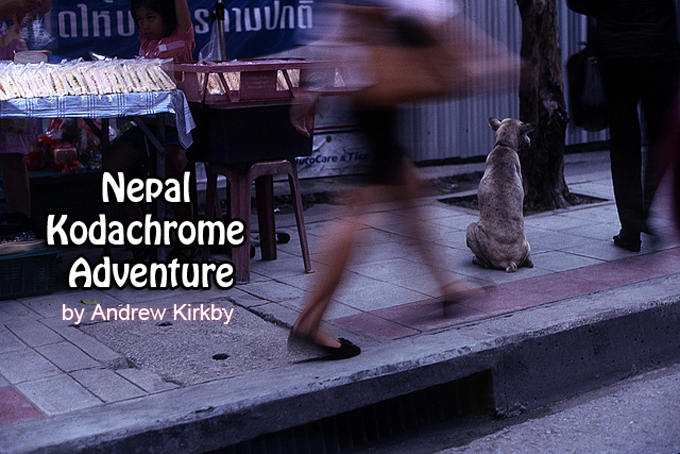
Nepal Kodachrome Adventure by Andrew Kirkby
It has taken me a year of thinking and reviewing my images before i could get this together for your readers. I think that Kodachrome enabled me to take pictures reminiscent of the National Geographic magazines which inspired me to pick up a camera as a teenager (my father has every single one since 1967). I shot so many rolls of film during my trip to Nepal – it was very difficult to select images which I feel I should show others. So here they are, and a little about them is included where necessary.
Upon arrival in Nepal i went about shooting straight away. What struck me straight away is the amount of dogs everywhere. In every street, alley, alcove or shop. They don’t belong to anyone other than the city.
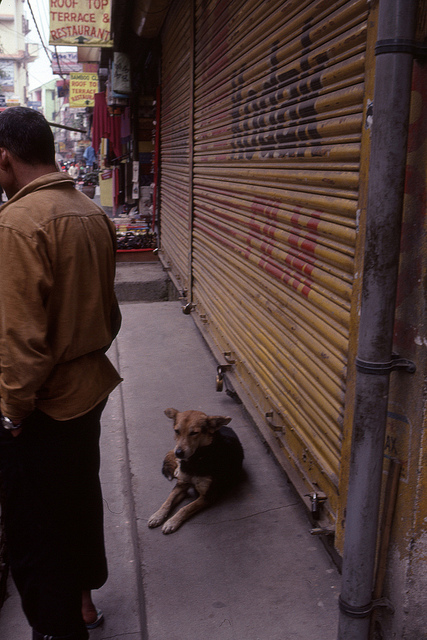
–
A dog scavenging for food near the highly polluted Kopan River (Kathmandu). The smell was terrible.
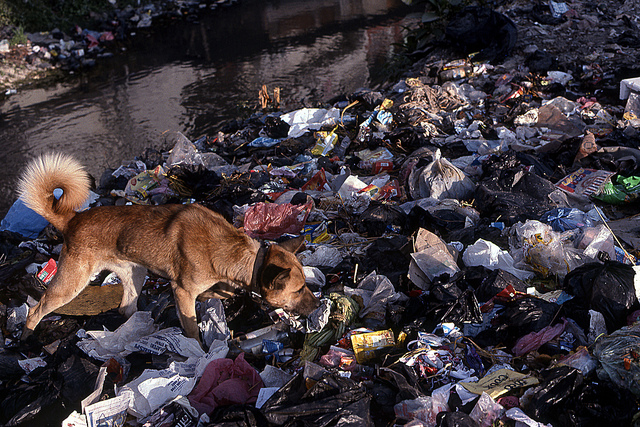
–
This particular scene is something i will never forget. The shop in the picture is that of a butcher, and the dog in the street has run in, grabbed a piece of meat off the counter and run away. The shop keeper’s dog doesn’t bad an eyelid and the woman just carries on as if nothing had happen.
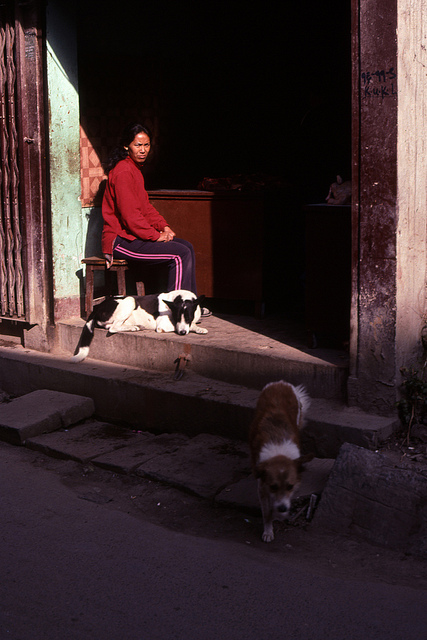
–
While driving along in a taxi, a boy came up to the window and demanded money. I had the F5 in my right hand and quickly took the shot. The kid instantly went mental and my friend Tashi needed to get out of the taxi and sort the kid out to avoid further trouble. Tashi later told me that he knew this boy and he told me that he was severely burnt while inhaling glue fumes.
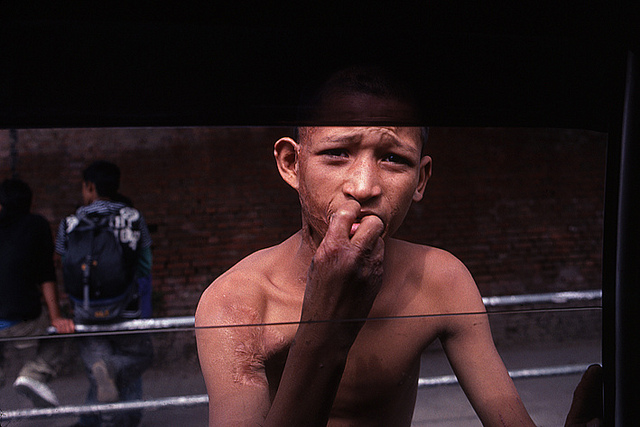
–
As I walked further and further away from the tourist district (Thamel) into Chhetrapati and surrounding areas, I found the real Kathmandu. People going about their normal lives and no hustlers trying to sell dope/underage girls/mountain tours!
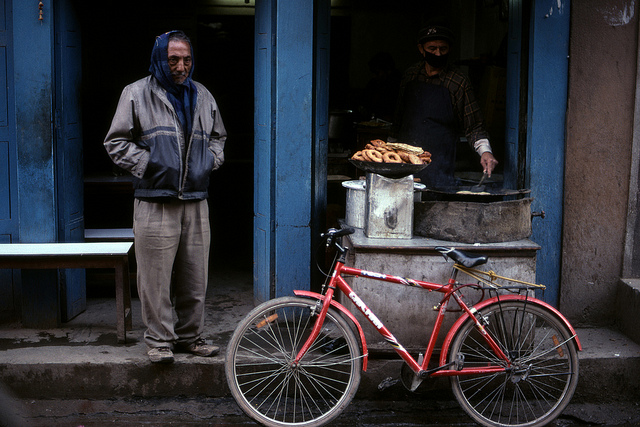
–
By night Kathmandu is an interesting place. A lot of shops are still open well after sunset. They are often lit by candles or rechargeable lamps as there is a scheduled blackout scheme in place. This butcher shop is one of my favorite images of the whole trip. In front of this table there was a stack of cages full of chickens awaiting their end. Sadly there was not enough light for a picture of those.
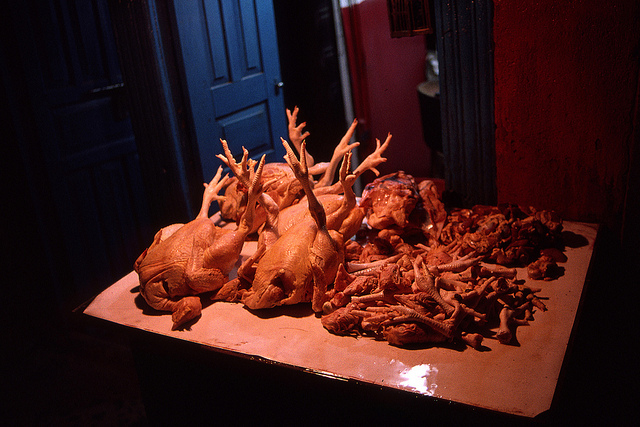
–
–
Walking back in to Thamel at night is an interesting experience. There are countless children on the streets who are often sniffing glue or smoking cigarettes – courtesy of tourist donations. Here they are sniffing glue – which can be purchased for 5 Rupees at almost any store. The kid standing up (on the left side) has just had a huge amount of glue and is about to fall over. I had to leave immediately after taking this photo to avoid a dangerous situation.
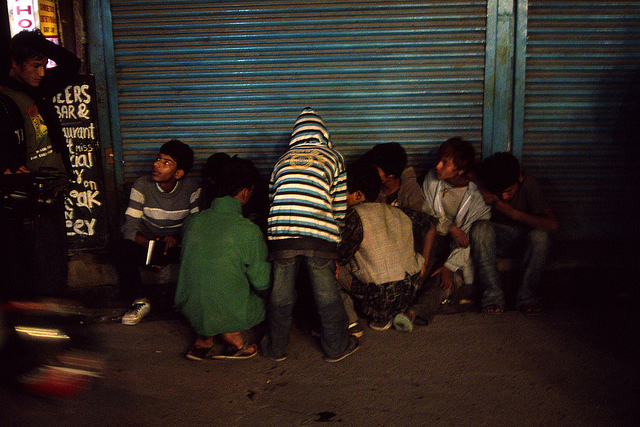
–
Walking back in to Thamel at night is an interesting experience. There are countless children on the streets who are often sniffing glue or smoking cigarettes – courtesy of tourist donations. Here they are sniffing glue – which can be purchased for 5 Rupees at almost any store. The kid standing up (on the left side) has just had a huge amount of glue and is about to fall over. I had to leave immediately after taking this photo to avoid a dangerous situation.
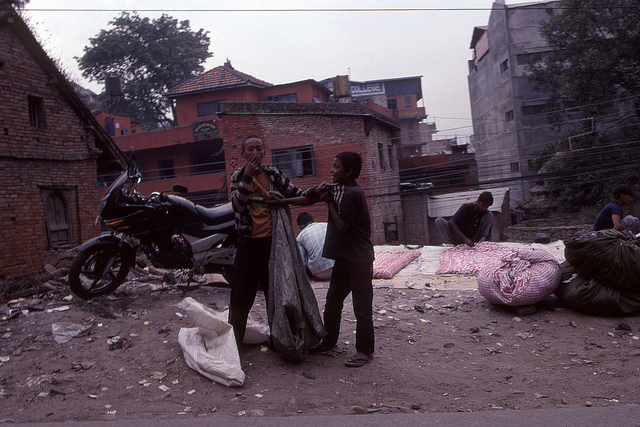
–
The rubbish which can not be sold is simply burnt in little piles all around the city at night. That would explain the huge amount of thick smog.
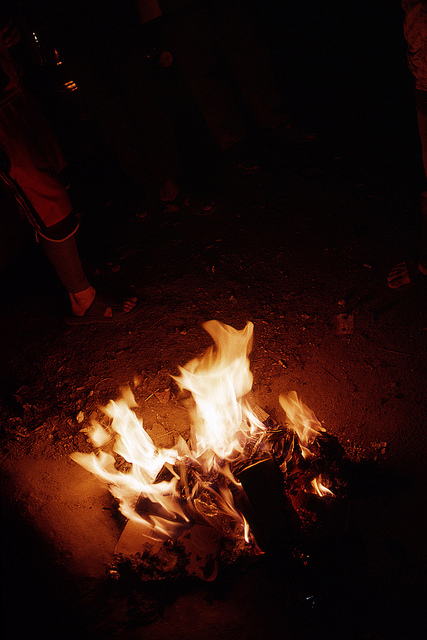
–
After a week in Kathmandu I flew into Lukla; one of the world’s most dangerous airports, and began a 3 week trek to Gokyo Ri and back via the Everest region. The airline that i was flying had a serious accident in August of 2010 – a flight destined for Lukla but forced to turn back in poor weather, and subsequently crashed just outside of Kathmandu. I was scared, to say the least.
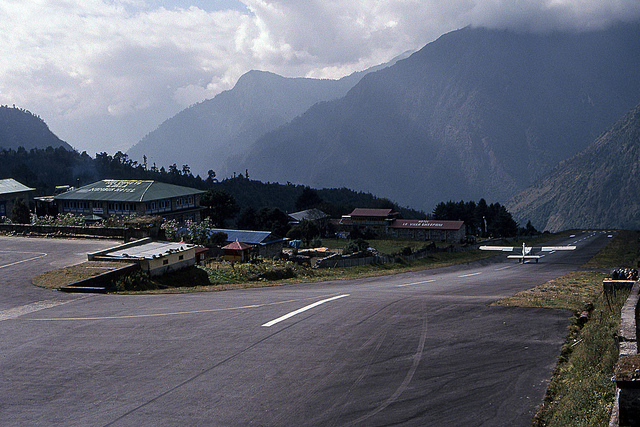
–
It is interesting to note the completely different complexion of the people in the mountains. In the Khumbu region, the people are mostly Sherpa – very similar to Tibetans or Mongolians. Typically very kind, warm and hospitable people.
I guess this is what i came to Nepal to see – the mountains and the people who inhabit them.
One thing that was refreshing for me, is that children are outside playing with sticks and other such objects. There is no Xbox, Playstation, TV or computer. Kids are just kids.
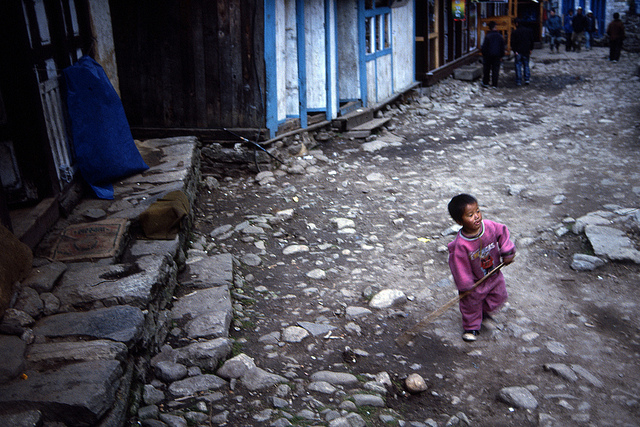
–
A young boy playing with firecrackers. Something not seen here in Australia for a long while (before my time!)
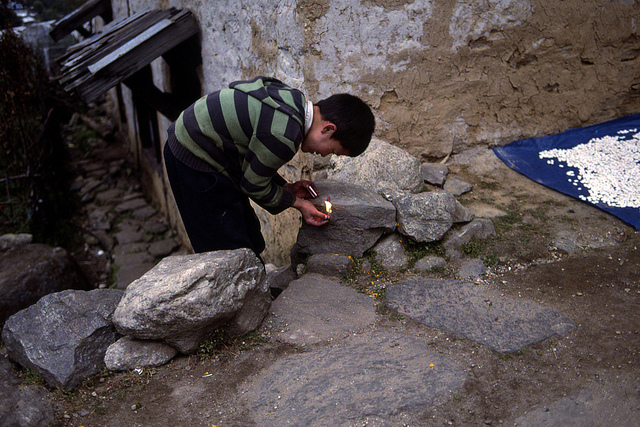
–
After a few days walking we arrived in Namche, the largest town in the area. Lots of tourists and yaks.
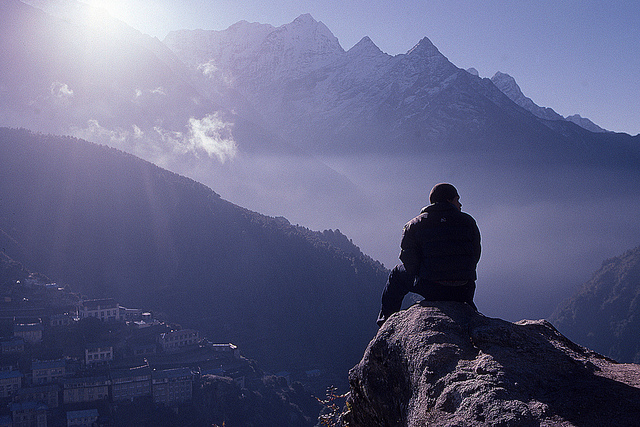
–
This picture was taken just above Namche Bazaar late in the afternoon. The Sherpa people are very hard workers.

–
I noticed that the altitude had a profound effect on my thinking. I saw the dark side of things, and at times i felt rather belittled by the enormous mountains. These next few images were shot while descending from Gokyo Ri, feeling rather ill from the altitude.
–
This is one of my favorite mountain shots. The moon and snow blown off the mountain was really quite spectacular. It was one of those moments that only lasts for a short time.
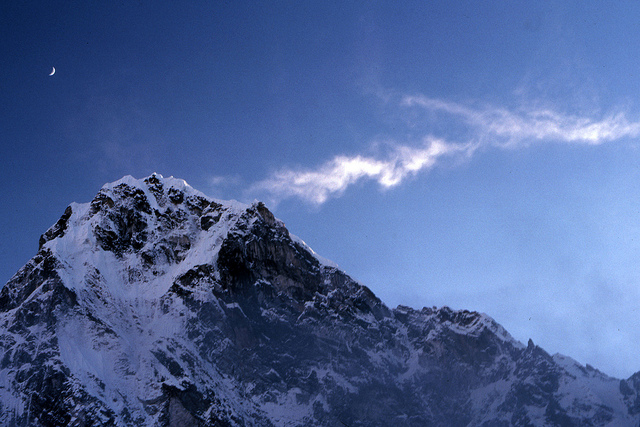
–
[ad#Adsense Blog Sq Embed Image]
Ama Dablam at sunset

–
A few days later, a bit further away.
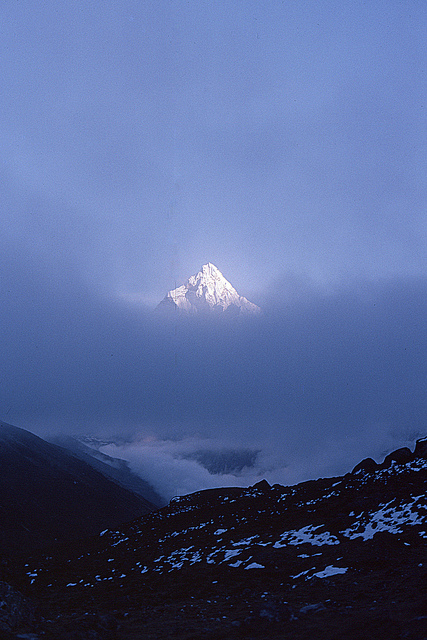
–
At the top of the Cho-La Pass. These black birds were everywhere
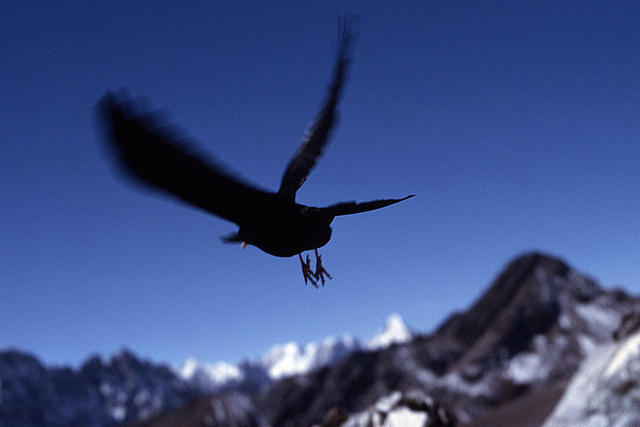
–
Near Everest Base Camp… I had to take a picture of at least one Kodachrome box on the trip.
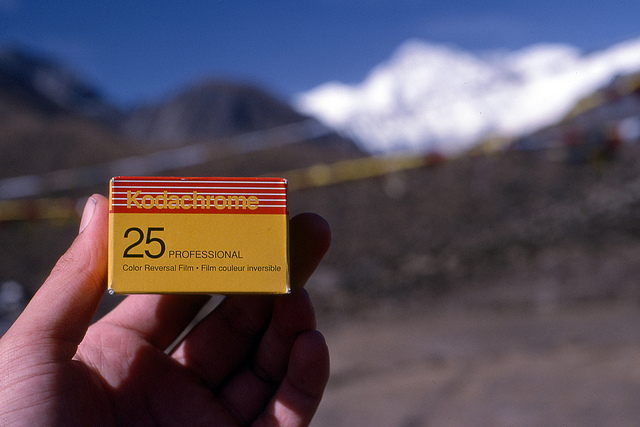
–
Back in Kathmandu for about a week before returning home, I got up every day at the crack of dawn and went out shooting until I couldn’t do anything more. The way the light is recorded with this film is simply beautiful. It has just the right amount of contrast.
–
–
I still don’t know what this woman was pointing at.
–
–








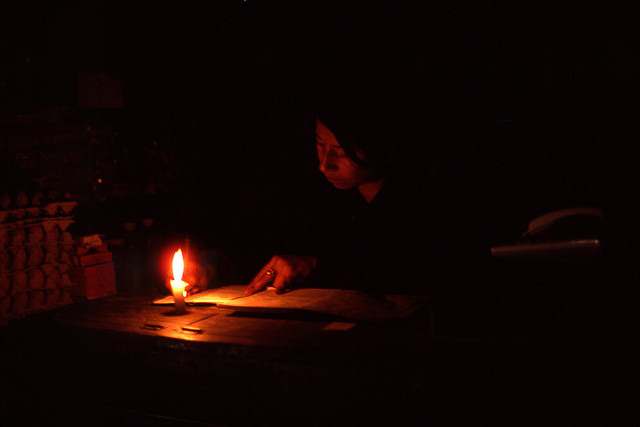








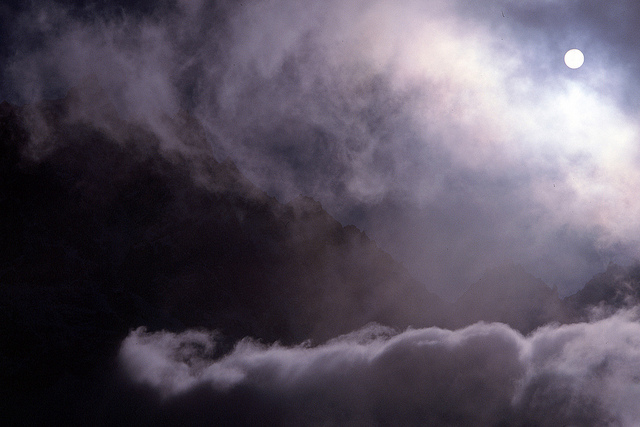
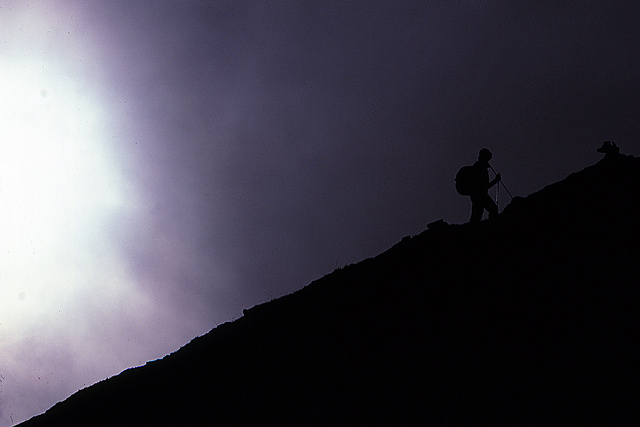
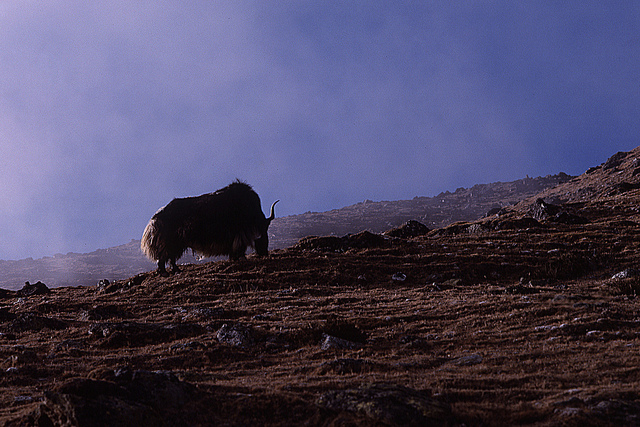





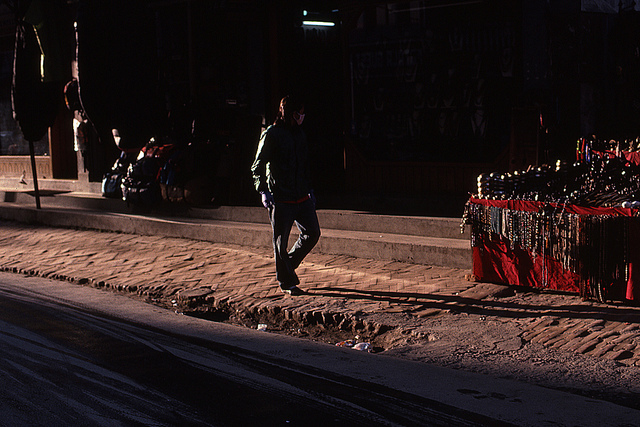
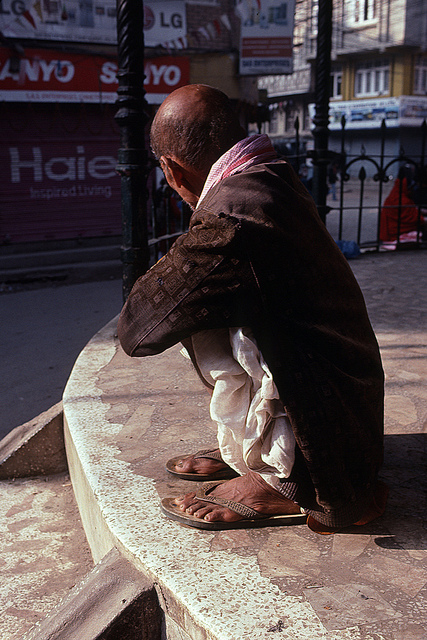
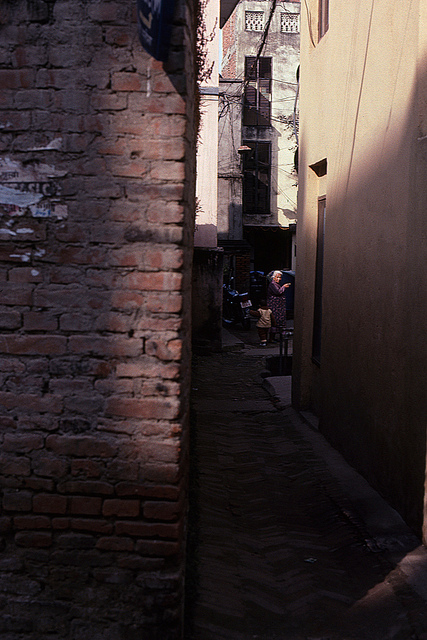
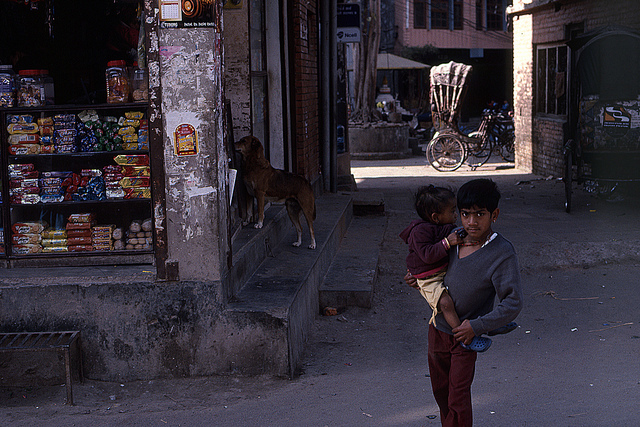


Really nice shots. Not the typical tourist type pics. The colours are great.
Wonderful shots that bring back good memories..I can smell different scenes..nice to be reminded of the dogs actually, they get hairier in the mountains and look happier..I bet you got fit!
Hi Andrew. Great job mate. As a Nepali based in Australia, seeing those images of Bagmati river and the street kids breaks my heart, but thats the sad truth. I was glad to see that you did not include any “postcard” shots and remained true to the truth-which basically is the constant struggle to make a living for better part of the population.
wow…and nothing even comes to film. No faking- no added emotions. Just as it is. Nice and simple. Light and shadows. That’s what I love about film. Things look just right.
If anything does not look right….i know straight away…its my fault and I try my best not to repeat it the next time.
I admire your lack of temptation of digital cameras even on an “exotic” trip.
Discipline and thinking pays.
Great work.
Cheers!
hallo Andrew… nice pictures, beautiful colors..!
I think I made photo of this nepalese woman with baskets and branches around Ama Dablam region last year!
https://picasaweb.google.com/105182115419865674674/Nepal201002#5555490273579633266
such a small region…:-)
best
P.
Peetr,
Yes it is definitely the same woman! She couldn’t speak – i’m not sure why. My guide didn’t know.
I had a look through your other images – there is some great stuff there.
I love this: https://picasaweb.google.com/105182115419865674674/Nepal201002#5555489554481383794
and this
https://picasaweb.google.com/105182115419865674674/Nepal201002#5555489896350439474
Thanks for that 🙂
Andrew
Andrew,
she was little angry (without words) with my taking picture of her 🙂
Sometimes I can see in somebody’s photo the same people even on pictures from Kathmandu…!
Beautiful country and people
Thanks !
Petr
Stunning
All of them.
It made me feel happy to see these shots. I like that you took the pictures to tell a story and show us all things we might not have seen instead of making pretty images. This also reminds me why I still shoot film.
Rick, I think you had a good question. A lot of it is to do with the color quality. You don’t get such a natural color palette with digital.Each film had it’s own color quality, Now, you are at the mercy of the sensor or technology built into the camera.Yes, you can tweak it but I haven’t seen digital images with the look of kodachrome yet. Some digital cameras even have ahem! ‘film’ modes to try to duplicate the look of film. We might ask ourselves why they bother to do that if ‘digital’ color is so good. That’s another way of looking at it.
The reason I still use film (and an M6) is that I don’t like using menus on cameras and I still feel the controls,viewfinders etc. are still better on film cameras. The new m’less cameras are catching up though and are tempting. After shooting on film and scanning my pictures still look good BUT the smoothness, tonality and color of film and a nice print from a negative are just not there.
Perhaps it’s something to do with an artistic sense. Some people can’t see much difference between instant custard and real custard, they are happy with the taste of either. Some people can’t audibly tell the difference between a cheap audio system and a high end one. Nothing wrong with that of course, But if you CAN tell the difference, then you can appreciate the difference between film and digital. The original image on film is pure in the sense it is light going straight through the lens and on to the film. With digital it’s going into a sensor and processor, a bit like a washing machine. The pictures come out clean but not necessarily the same as they went in.
What I do truly love about digital is how good it is at getting the exposure right on the money and even in low light.But I have some rolls of unused Kodachrome sadly wishing they could be used and processed!
Steve,
Thanks for your comment – i thought about the text… i think some of the images are “one sided” without providing the context.
You’re definitely right about the tactile aspects of film cameras. There is something very pleasing about the “snick” of a [film] Leica shutter. The FM3a sounds a bit less luxurious, but as described on another site – it’s like a gun: you press the button and it goes off straight away with no electronic governor getting in the way. The F5 is considerably more noisy, but it is blisteringly fast and the optics are great too; noticeably better than a D3 and worlds better than a mid-range digital (D80, 60d etc). The Leica is in a different class.
Colour is a big problem with digital, with some exceptions. The problems associated with bayer interpolation mean that you are essentially getting an approximation of what was there. Film does have idiosyncrasies too – look at the way Fuji slide film renders blue sky, or how Kodak slide film renders reds and browns. I guess it all comes down to preference. There is a good article on Oleg Novikov’s page about this particular matter.
As for exposure… I see no real difference when the cameras are used properly. I use a handheld incident meter a lot of the time, so that takes the camera’s meter out of the equation.
Keep that Kodachrome frozen, there are a few people working on chemistry and couplers to develop it.
Andrew
Just wanted to add to the praise. There are more than a few keepers there Andrew.
I’m trying to budget out shooting around 1-2 rolls a week for the year (I’ll develop the b&w myself). I’m already behind as we’re well into the new year, but your work has inspired to shoot more film. The medium may not be important, yet somehow there is both an intellectual and spiritual connection to film that makes me want to use it as a photographer. For that, I wanted to say thank you Andrew. I hope everyone shoots more film, including you Steve. Happy belated New Year to all.
Gil,
Thankyou so very much. I am very critical of my own work and it is good to hear all the positive comments, rather than the internal conversation i usually have going… 🙂
Black and white is great. I learnt B&W printing while at school but didn’t come back to B&W film until around 2009 when i bought a medium format camera (Hasselblad) and had run out of Velvia to shoot in it. I might go shoot a few rolls of film in the coming weeks and see what i come up with. Tri-X or HP5+ pushed a stop is always a great choice, as is Pan F shot with tungsten light. Skin tones look phenomenal with Pan F… you get that “classic” look, especially with older lower contrast lenses.
Keep us updated with your results – i’d love to see what you come up with. Do you have a Flickr page or similar?
Best Regards,
Andrew
Really like this photos and the story. Thank you.
per
Nice pictures, and a great film too, thanks for sharing your work
Matthias
Thanks for sharing this Andrew, this was a really great photo essay. I’ve toyed with picking up an old film camera for awhile, but haven’t seen anything to justify the hassle. This is making me want to order an old Konica or Nikon to go with some of my legacy lenses and shoot some film before I return to the States! Really great work!
Wes – thankyou so much for your kind words… I am glad that i have inspired you to shoot some film… Where are you currently located?
No need to spend big on cameras… a FM2n would be more than adequate. Check out the new Kodak Portra 160 and 400 films… or maybe even some Provia from Fuji depending on what you want to do.
Thanks again,
Andrew
Thank you for sharing Andrew! Brilliant photos, great story telling, and I love that you used kodachrome…
Thank you very much Andrew, for sharing your experience with us. Your photos and narrative really evoked an emotional reaction from me. Powerful photos. Thanks again!
Love film, please keep it coming.
This is seriously good photography. Thank you so much for sharing this great story.
Love the Kodachrome colours.
Awesome shots Kirkby! Love the compositions and story telling.
Steve,
Nice pictures, love th look of film.
BTW: The first picture with title of this article is actually from Thailand. The sign behind sandwich stand is written in Thai.
Vitoo –
Thanks for your commment – and yes, i think you are right. I stopped over in Bangkok and blasted some film there – some slides got mixed up. Nice spotting! 🙂
(oops)
Andrew
Love the images and your impression of your trip. Extremely interesting. Gotta love those kodachrome colors.
Congratulations for the photos, they are wonderful. They do indeed remind me of the old National Geographic look, which sadly, recent digital work doesn’t reproduce anymore.
Very few people still shooting film nowadays, especially slide. Of those, even a smaller percentage are shooting K-14. Respect!
superb
Incredible. Great stuff! I’m inspired
Film again! Thanks
Gorgeous documentary! I am very interested in your trip. You say there are plenty of tourists in Nepal is it a really tourist friendly destination or more of a raw backpacker type adventure.
Thanks for your comment – i am happy that i could share these images with you.
Nepal is very much based around the tourist economy. There are tonnes of places to stay in Kathmandu, and a fair amount of tourist traps – but i guess the reason why most people go to Nepal is to see the mountains – specifically the Everest Region (Khumbu) and the Annapurna region. I would like to go back in the spring and spend a month in the Annapurna region – one of my other influences is Galen Rowell, who spent a lot of time photographing the mountains in Nepal (and a lot of it on Kodachrome II and Kodachrome 25/64 during the 1970s and 1980s – he later switched to Velvia). Have a look at his book “Mountain Light” – also the name of his gallery and website. Unfortunately, Galen is no longer with us.
I think in most cases the accommodation is adequate but by no means luxury. I am not one to fuss over quality of accommodation, so i may not be the best judge.
Cheers,
Andrew
Great post Andrew. You captured some great moments and I love looking at how the film has handled the exposures. Excellent. Thanks for sharing these.
Well, what to add to what´s allready said? Great pictures, moving stories! One of the many things I like about this site is the way its readers interact; thoughtfull, with respect to another and by sharing the passion for photograhpy.
very inspiring trip…
the photos really tell stories..
I am glad you share those with us
Beautiful.. good stories..
William
What a good trip!!! Thanks for sharing.
wonderful shots! thanks for sharing! i love the fifth: great color combination, the blue door frames highlighted by the jacket and in front a red bycicle, reminds me of a “alex webb”. too bad kodakchrome has been discontinued ;(
Very telling photos and very sad to see the youth engaged in drug use. They could use some communist discipline to stop the drug scourge.
awesome series. love the colours!
Thanks for your time and information! This is for Avi and Jon … I kind of get it but I am a little thick — some of your information makes sense and some is a little more complex than I can absorb… hahaha… my issue, not yours! Thanks again and peace to you and your family. Later!
That’s it, I’m quitting my job and hitting the road again.
Hey, Steve, or anyone… I have a question that has been bugging me for a while and Andrew’s submission made me think of it….
Everyone tells me (the pros that is…) that nothing captures the world like film, real film, so how does one take pictures with film and then get them on the computer without going ‘digital’? Seriously, what does it matter to use film and then scan it and now you have a digital picture. So what’s the point of having that middle step? Why not just shoot RAW in digital and one can adjust every aspect of the photo. Thanks for the thoughtful replies! Take care, all!
Hi Rick,
There’s a multitude of reasons why some people prefer film over digital.
It could be colour rendition, the greater dynamic range (usually), better highlight protection, the organic look from the grain.
I personally like both film and digital equally and therefore shoot black and white film and colour digitally.
I’m sure others can fill in on more reasons to pick one or the other.
Thanks for your time and information! This is for Avi and Jon … I kind of get it but I am a little thick — some of your information makes sense and some is a little more complex than I can absorb… hahaha… my issue, not yours! Thanks again and peace to you and your family.
Rick —
+1 on what Jon said.
Film has a different look than digital–even when scanned. Not better or worse, just different.
Rick, your questions about this won’t be easily answered in words or by looking at a computer screen. It’s probably a more emotional than logical choice. These days, good medium format cameras can be had very cheaply, often for far less than the cost of a new digital body or lens. My suggestion is to buy one, shoot a few rolls of E-6 film like E100G or Velvia 100, put it on a light box or window, and SEE for yourself what film can do in real life. I know I was stunned.
Or if you want to be lame about it you can search flickr for tags like “Portra”, “Ektar”, “Reala”, “Velvia” etc.
I’ve been asked that too (people felt it ironic somehow that I would shoot film sometimes and scan my negatives), but it’s as simple as this – generating an original on digital involves the digital interpretation of what’s being seen by the sensor….the original colours, light etc. are interpreted into the 1-0’s. With film, the original colours and light itself reacts with the film surface to a physical depth and permanence (rather than an interpretation). Scanning film later to digital doesn’t make it hypocritical, any more than painting a picture with watercolours and scanning that picture it does….scanning a painting to digital doesn’t make the original painting digital, nor does it have the texture of the original painting. It may have the ‘resolution’, and may be in fact of supreme quality. That’s why a lot of B/W film lovers like to print their favourite negatives in the darkroom, on specific archival paper of a certain quality for it’s ‘painterly’ original quality and texture – it physically has a depth to it just as painting a canvas does. I shoot both digital and film, and like both for different reasons. I scan my negs out of convenience and for easy viewing/sharing/publishing in mags. But they look very different from my digital originals. I sure wish Kodachrome was still available and could be processed – it was my go-to film for outdoors in the mountains on expeditions and trips. Best film ever. I truly miss it.
I don’t see any need to get them on a computer (unless you want to post them on a blog).
Rick,
I guess when you sit in front of a computer for 70+ hours a week – the fact that i can mostly avoid the computer for my photography is a big bonus.
Also, the workflow is better when out in the field. It’s a bit impractical to take a laptop, memory cards, battery chargers and all other associated equipment related to a digital camera when you are carrying it on your back for 4 weeks. At the end of the roll, i put it back into a canister and that’s the image done. No post processing (apart from the scanning) and no photoshop make life a lot easier for me.
I did however work for Canon for some time, and have used digital cameras extensively. So it’s not like i’m anti digital or any of that. There are merits of both technologies.
well said…
For those new to photography, there is a thing called ‘optical printing’. ‘Back in the day’ – i.e. before digital – it was just called ‘printing’. You took the developed film or transparency and printed it via light, shining the image onto photographic paper through something called an ‘enlarger’.
Those around in those dim, distant days will attest to the beauty of prints, Cibachromes, etc. produced without any interim digital stage. Taken with light: printed with light.
If you didn’t want prints then positive images (transparencies) could be ‘projected’ – again using light – often at vast magnification, whilst still retaining superb quality at normal viewing distances. This still exists occasionally in a medium called ‘movies’ I believe ….
OK – sarcasm aside (only joshing Rick) ‘pros’ or enthusiasts …. call them what you will …. appreciate that digital is not the be-all and end-all of photography. Film is an experience as well as a medium. Kodachrome film in particular has a physical structure peculiar to it’s technology that is almost 3D if viewed from it’s rear, matt, side.
Objects literally appear to stand out from the surface of Kodachrome film. Digital would die for that type of technology ….
It is this, plus it’s sharpness, minimal grain, superb resolution etc. that make it a film that was not only used, but loved with a passion. No amount of RAW adjustment can rival the physical experience of using film in general, and Kodachrome in particular.
If film were as cheap to use as digital, I’d still be using film exclusively.
You mention “cheap” being a factor in using digital cameras. Let me spin it another way.
One can shoot remarkable images (rivalling even the best 35mm full frame digital cameras) for the princely sum of $3-8 a roll + process & scan. It forces you to slow down and shoot fewer images, but the ones you do shoot are of a better standard.
Say it costs you $0.50 per images once all is said and done;
An average digital SLR camera costs ~$1000 so that’s about 2000 frames on film. Sure, you can shoot 20-50,000 frames with a basic consumer DSLR before it falls apart, but how many are you actually keeping?
You can use it in a seriously high end camera like a Leica or you can use it in any crummy old film body… AND still do your digital post processing on the scanned film. You get the best of both worlds.
Give the new Kodak negative film a try. The Portra 400 is absolutely astonishing and scans very well – i’ve pushed it 1.5 stops (1000 ISO) with very little increase in grain or colour shift. Even rated and pushed to 1000 ISO it still has less grain than Kodachrome 64 at its box speed. Technology has come a long way in 40 years 🙂
The new Portra 160 is even better.
I am a big fan of compact/pocket digital cameras for portability and use where it may not be feasible to have a larger film camera around – for instance, keeping in the pocket while going to work. The Fuji X100 and Canon S95is are my preferred weapons of choice there.
Use whatever works for you at the end of the day – the making of the images is the important bit, not the gear 🙂 (famous last words)
Andrew
Film has a different look than digital. High ISO film is produces “grain” High ISO digital produces “noise” That distinction in terminology is telling as “grain” is organic, living, and beautiful while “noise” is unwanted. With film cameras you have the option of so many different types of sensors (except for Kodachrome) while with digital you’re stuck with the sensor that’s fixed inside your camera.
Scanning is only a means of digitally archiving your photos, nothing more.
In all reality, it really doesn’t matter what you shoot or how you process it as long as you’re having fun and the results are pleasing to you.
A great set of photos, really great. Your mountain shots are fantastic.
Breath taking! Very reminiscent of Nat Geo, as you said. I prefer slides over digital, but to me is prohibitely expensive. I would shot a roll once in a month, but there are no places here to develop this film.
On the other hand, very sad situation of the Nepal people. I’m sad to see all those kids wasting their lives. You were very brave to shot those images.
Congratulations!
hello Julio,
in which way do you think are these children wasting their lives? And how do you not waste a live? that would really interest me.
Kind regards
Are you serious ? How about degrading your own sense of identity and conscience and turning into a numb, anesthetized senseless addict, obsessed with one and only function: get more drugs.
When saying they’re wasting their lives you can take it as a moral judgment but on all practicality they’re wasting their time, day by day they’ll do nothing more than getting high, and days turn into weeks, into months, into years, into a lifetime. They have no hope of forming a family or pursuing their dreams or forming any bonds beside those convenient for the purpose of getting drugs.
What is great about this photos is the that they give enough freedom for the reader to value those observations and form their own opinion. This is why photography (documental or otherwise) is such a great tool to the understanding of other activities, cultures and ourselves as humans; what we do, how we live, why we are the way we are.
Thanks Andrew for this wonderful contribution, I wish I could someday do what you’ve achieved here and get out there, know new people and places, unfortunately the world it getting smaller and smaller and cultures are fading into homogeneity. it’s really a shame.
Ditto
This is wonderful. I loved both the text and the pictures, and would love to see and hear more. This truly sounds like an edventure. And to take it with a Nikon F5 and Kodachrome–Steve McCurry style!
FM2n. Afghan girl. 🙂
One of the many wonderful things about film is how it forces you to slow down and ask “is this a good use of this frame?” With the discontinuation of Kodachrome I’m sure you had to pick and choose your photos even more carefully and the results show!
Beautiful film and beautiful photos.
Wonderful.
Hi Andrew,
Great shots, particularly those of the mountains. Where did you scan these images? At home? You should probably have some more landscape shots with this set. You can share some of them.
Cheers,
Mo Han
Mo Han,
Actually, a friend of mine scanned these for me. I’ve got a lot more images, but i thought these were the strongest ones at this point in time.
Feel free to get in touch and i’ll share some more with you.
Regards,
Andrew
great pictures….. still crying every time i remember this film
all these were shot with nikon f5 right?
nice post
boris
Hi Boris, I took an FM3a and an F5 on this trip. I found myself using the FM3a more as it was a bit more discrete.
Thanks 🙂
Andrew
I was curious to know what lenses you used. And was the weight of all your gear manageable, or a nuisance?
Joe,
The amount of gear i took was definitely too much in hindsight, and carrying it for the first few days was really a stretch.
I took the following gear:
F5, FM3a with a motor drive, 24mm 2.8 Ai-S, 35mm f2 AF-D, 50mm 1.4 Ai-S, 105mm 2.5 Ai-S, 200mm f4 Ai-S.
In addition to this, the Lowepro camera bag (Protrekker 400AW) i bought from B&H was fantastic to carry, but was quite heavy and bulky even unloaded. Throw in a rain jacket and polar fleece top, 40 spare lithium AA batteries (which i didn’t use), a SB28 flash, flash diffusers, different filters, a manfrotto Carbon fibre tripod and all my travel documents – the total weight was about 17kg.
I feel i could have taken a fair bit less, and maybe in a smaller, less bulky camera bag. I put the majority of the film (~120 rolls) into my bag which was carried by a porter (sleeping bag, clothes etc), so that wasn’t too much of an issue.
I could have done all of the street photography with a 35 and 50mm lens – maybe next time i’ll take a rangefinder and absolutely minimal ancillary equipment. The mountains require a bit more diverse selection, maybe one wider and one medium-long telephoto, which is why i took the Nikon kit. It’s also considerably cheaper. My total investment in Nikon gear cost a fraction less than my Leica M6 TTL body.
AK
Wow! Quite the load! Your back must have been hurting.
Good lens selection, though. It’s hard to know what one will need, so best to bring it all. A couple of zooms would have worked, I imagine, but not given the clarity and quality one desires.
Not that I’m plannng any major adventure like traveling to Nepal, but the older I get, the less weight I’m willing to carry. I love my Nikon gear, but it’s all so big and heavy. Thus, the Pentax gear is getting more use.
A rangefinder would be great, but I imagine you’d be nervous taking that Leica too far from home.
Thanks again for sharing your story and great images.
JG
Very nice work. I like it.
Some truly beautiful film shots, this isn’t a critisism but perhaps the post would have had more impact with a few less images and no text? Thanks for sharing these.
Jason, Thanks for your kind words…
I figured i should say as little as possible… maybe that was too much? 🙂
Andrew
Hey Andrew,
I’ve read it again since, If its too many words it was only a couple too many..:-)
Cheers
Jason
I appreciated the text. It gave me a better understanding of what was going on in the image, as well as a better understanding of Nepal in general.
Thank you Andrew for a very well written post and for sharing your amazing images.
I think the text was just right for a photo-essay like this. It was enough to give context that enriches the shots, without being daunting to the reader. I think it it was just the pictures, I would not have given them as much attention.
Just Beautiful! There is a depth and clarity to these images that is hard pressed to get with any digital camera. Great work and story.
Beautiful images, thanks for sharing.
best shot were the Ama Dablam peak from afar & the black bird flying away.. simply fantastic..